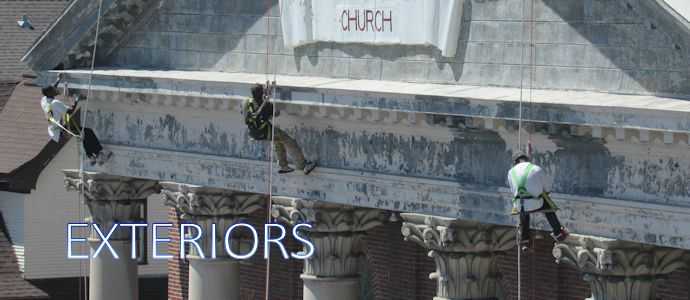Painting a church can be a complex and challenging process, particularly if the church is historic or has significant cultural or religious value. Some of the complexities involved in painting a church include:
1. Access and safety: Many churches have high ceilings, steeples, and other features that require specialized equipment and safety measures to access. It is important to ensure that the painting crew is properly trained and equipped to work safely at heights. Our crews receive specialized training to safely work where many painting contractors wouldn’t consider.
2. Preparation: The surfaces of a church can be complex and varied, including wood, stone, plaster, and metal. Each surface requires specialized preparation and painting techniques to ensure that the paint adheres properly and lasts for many years. Before painting can begin, the church must be thoroughly prepared and any loose and flaking paint or coatings removed. This can be a time-consuming and delicate process, particularly if the church has fragile or ornate features. Depending upon the age of the church lead paint may also be a factor. Other considerations in the preparation may include proper repairs to the church’s surface.
3. Choosing the right coatings: The first consideration is to chose the right product for the surface to be painted. You will also want to use a premium product, always. Typically the materials are not the major factor in the cost associated with painting your church and a premium paint can make the difference of several years before your next painting project. However, there’s much more to consider. Churches are often important cultural and religious landmarks, and painting the church must take into account the sensitivities of the community. This can often require a collaboration with local historical societies and the church to ensure that the work is respectful to the laws governing a historical landmark. This will often include color selection. Choosing the right colors for a church can actually be a complex task, particularly if the church has historical or cultural significance. It is important to select colors that are appropriate for the style and period of the church, as well as colors that are meaningful and symbolic within the church’s religious tradition.
4. The actual painting: For maximum adhesion and color retention make sure to paint within the weather diameters (temperature and humidity) recommended by the manufacturer. The method used in the painting also makes a difference. We caution against spraying when wind, overspray, and other factors may turn a simple painting project into a disaster. With spraying it is also easy to underspray and not apply a thick enough coating. Therefore, for most projects we use brush and roller to apply an even coat that will last and look good for years to come.
5. Liturgical art and gold leafing: Unlike most residential and commercial painters the church painter must also be experienced in a more artistic approach to painting. Utilizing murals, iconic artwork, stenciling, and special finishes for the church painter to create a sacred place that promotes an atmosphere of worship.
Time and budget: Painting a church can be a time-consuming and expensive process. We are mindful that a painting project can sometimes be disruptive. Therefore, we utilize techniques that are less invasive and consider the church’s schedule a priority. Let us work around your schedule. This takes careful planning and requires adequate time and resources to ensure that the work is completed to a high standard.
www.imspiredheights.com

